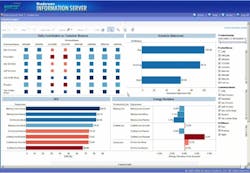Manufacturing intelligence software bridges many gaps, enabling information to be collected and shared across many boundaries: plant floor and control room, operations and business management, etc. It also can present challenges, not the least of which is knowing which software licensing method to use to cost-effectively get everyone the information they need.
Invensys recently announced that its Wonderware Intelligence 2012 software—which collects, aggregates and contextualizes operational metrics from multiple industrial data sources in near real time—is now available with concurrent licensing, in addition to traditional named-user licensing. I asked Maryanne Steidinger, director of advanced applications product marketing for Invensys, to explain how concurrent licensing works and why a plant might want to take advantage of it.
“A named user license means that that person, and that person alone, has access to the application,” Steidinger explains. “Concurrent licenses are used when the access to the application is done on an intermittent basis, like once or twice per shift, with multiple users needing to access a single client station or application. It is easier, and sometimes more cost effective, to use concurrent clients versus named users.”
Consider this example: You operate a cereal plant in California with three shifts, six days per week. You want to understand the yields of each shift, such as material going in, material coming out, percent good, percent of waste, percent of rework, number of stoppages or unplanned events, by shift. You also have another plant in Iowa producing the same cereal product, so you'd like to understand the same measures, and you’d like to compare plant-to-plant efficiencies to know which plant is doing better. Each plant has six to eight workers per shift who are responsible for the uptime, maintenance, operations etc. They use enterprise manufacturing intelligence (EMI) software to track progress against key performance indicators (KPIs), as well as other process control software such as human machine interfaces, batch management systems, etc.
“Because EMI is a dashboarding tool that shows KPIs, it is different from process-control- or automation-control-centric applications such as an HMI. Instead of controlling processes, it shows relationships between entities, such as energy consumption by shift, by line, by product, etc.,” explains Steidinger. “This less-granular approach defines the way a customer would interact with the application, and usage is normally intermittent and ad hoc, often based on queries, much like a business intelligence application.”
The sample operation might have additional shift staff working the weekends. Because the users change, the plant needs to constantly be using the same information for operations tuning and knowledge management. “Before concurrent licensing, customers used reporting products that were flat representations of the process [to share information],” Steidinger says. “They would show output, or quality, or energy consumption, but you couldn't get the dimensional or relationship part of the equation as you can with Intelligence/EMI software. This adds a richness to the reporting and analytical capabilities of the plant, supporting more informed decisions and helping personnel understand the complexities of the plant.”
Concurrent licensing reduces the administration usually required for such multi-plant, multi-instance intelligence software deployments. It is easier to administer, because IT departments do not have to monitor usage as closely. “Concurrent licensing automatically limits the number of users that can access the application at any one point to, for example, five or 10 concurrent named users. The software uses active directory or some type of security measure to ensure that the person logging in is that user,” Steidinger explains.
Named user licenses are typically less expensive than concurrent user licenses, but as the number of users increases, concurrent licensing makes sense. “A cost-conscious company may start with a defined number of users, and when the application proves itself, or when they are ready to scale across lines, plants, etc., they can upgrade to a concurrent user license,” Steidinger says. Looking at the difference in named vs. concurrent users from just a financial and license-consumption perspective, she offers this calculation:
- Eight workers per shift working three shifts per day equals 24 named user licenses.
- Because a maximum of eight workers per shift would be accessing the application at any one time, you would never need more than eight concurrent user licenses.
“So, if a concurrent user license costs maybe 1.5 times more than a named user license and you bought only eight concurrent licenses to share across shifts, everyone would be able to access the application during their shift, but your costs would be halved,” Steidinger says.
Bottom line: For companies with many intermittent, shift-based workers, concurrent user licenses can be very cost-effective.
About the Author
Renee Bassett
Managing Editor

Leaders relevant to this article:
